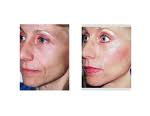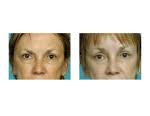As one ages, the entire face changes. Some parts of facial aging are more obvious than others as the face does differentially age. The forehead, brows, eyes, mouth, jawline and neck are all areas whose aging is well recognized. The aging of the midface and cheek areas, however, has only become more recently recognized.
With the aging process, the fatty tissue that normally drapes over the cheekbones can begin to sag. The result is less prominent cheekbones, and a droopy fold of skin and fat between the nose and the cheek (the nasolabial fold). The sagging cheek fat can also alter the appearance of the lower cheek. For example, bagginess of the lower eyelids often becomes more apparent after the fat of the upper cheek begins to sag. This in essence ‘unveils’ the bagginess of the lower lids, which have always been there. In addition to sagging of the skin and fat of the midface, there is also volume loss in the cheek due to loss of fat and muscle.
A number of cheek lift or midface lift procedures exist to address this aging area. The goal of all of them is to lift up droopy cheek tissue over the cheekbone restoring the more prominent youthful contour, improving the tear trough and bagginess of the lower lids, and softening the undesirable cheek fold. Fundamentally, they may be divided into lifting approaches vs volumetric addition. In some cases, they may even be done together.
Lifting approaches aim to reposition the sagging fat of the cheek over the cheekbone to restore the youthful fullness of the cheeks. Such midface lifts use differing access including the lower eyelid, scalp, and temporal incisions using open incisional or endoscopic instrumentation. Implants have also been devised to provide less invasive options including suspension sutures and bone-anchored lift devices. The plethora of differing lifting approaches suggests that no one of them is universally successful.
Contrarily, cheek implants have also been used to help create a degree of cheek lifting. By placing an implant through the mouth onto the cheek bone, some fullness is added to the volume-depleted cheek and the cheek tissue on top of the implant is pushed upward. While not creating as dramatic effect as a lifting procedure, it is far simpler and with fewer complications. This cheek lift approach, using a specially designed submalar implant which fits on the underside of the cheek bone, has been around for nearly two decades. When used in the right patient and properly sized, it can have a good cheek enhancement effect. But it is also easily overused and overdone (too large a size) as older celebrity faces are rife with examples of odd-looking and peculiar cheek prominences due to oversized implants.
Given the choices between cheek lifts and cheek implants, which is the most helpful for cheek rejuvenation? The answer is no one of them is best for all patients. Over the years, I have used almost of all of them in my Indianapolis plastic surgery practice and have also seen and learned the downsides to each of them. Midface or cheek rejuvenation is as much an art form as almost any area of anti-aging facial surgery. Given the potential complications that can occur with lifting procedures, most specifically lower eyelid ectropion, their use should be reserved for the most severe sagging cheek problems. More moderate cases with less prominent cheekbones may benefit with a small to moderate-sized implant. In all cases, moderation is the key with not too much lift or too big of an implant. The midface is one area that does not look good overdone and it is easy to have that happen.
Barry L. Eppley, M.D., D.M.D.
Indianapolis, Indiana





